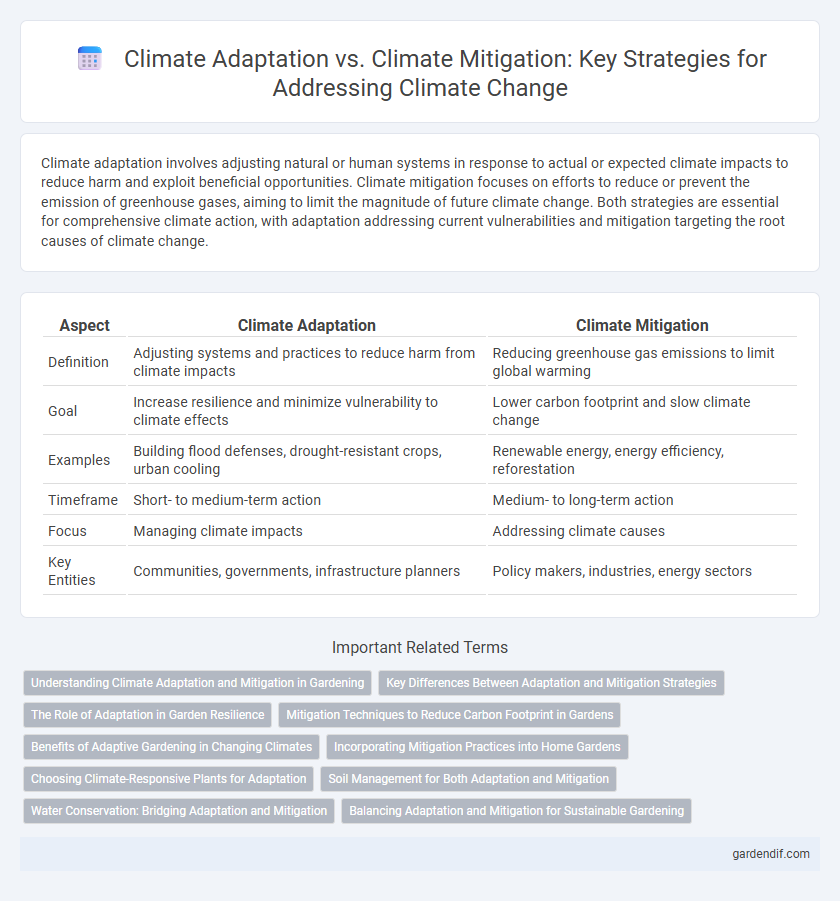
Climate Adaptation vs Climate Mitigation Illustration
Climate adaptation involves adjusting natural or human systems in response to actual or expected climate impacts to reduce harm and exploit beneficial opportunities. Climate mitigation focuses on efforts to reduce or prevent the emission of greenhouse gases, aiming to limit the magnitude of future climate change. Both strategies are essential for comprehensive climate action, with adaptation addressing current vulnerabilities and mitigation targeting the root causes of climate change.
Table of Comparison
| Aspect | Climate Adaptation | Climate Mitigation |
|---|---|---|
| Definition | Adjusting systems and practices to reduce harm from climate impacts | Reducing greenhouse gas emissions to limit global warming |
| Goal | Increase resilience and minimize vulnerability to climate effects | Lower carbon footprint and slow climate change |
| Examples | Building flood defenses, drought-resistant crops, urban cooling | Renewable energy, energy efficiency, reforestation |
| Timeframe | Short- to medium-term action | Medium- to long-term action |
| Focus | Managing climate impacts | Addressing climate causes |
| Key Entities | Communities, governments, infrastructure planners | Policy makers, industries, energy sectors |
Understanding Climate Adaptation and Mitigation in Gardening
Climate adaptation in gardening involves modifying practices to cope with changing conditions, such as selecting drought-resistant plants and adjusting watering schedules to withstand extreme weather. Climate mitigation focuses on reducing greenhouse gas emissions by incorporating carbon-sequestering plants, minimizing chemical use, and improving soil health to capture carbon effectively. Integrating both strategies enhances garden resilience and contributes to broader environmental sustainability goals by addressing immediate climate impacts and lowering the overall carbon footprint.
Key Differences Between Adaptation and Mitigation Strategies
Climate adaptation involves adjusting natural or human systems to minimize harm from climate impacts, emphasizing resilience and risk management through actions like building flood defenses or developing drought-resistant crops. Climate mitigation focuses on reducing greenhouse gas emissions to limit future climate change, primarily through renewable energy adoption, energy efficiency improvements, and carbon sequestration techniques. The key difference lies in adaptation addressing the effects of climate change already occurring, while mitigation targets the root causes to prevent further environmental damage.
The Role of Adaptation in Garden Resilience
Climate adaptation plays a critical role in enhancing garden resilience by implementing strategies such as selecting drought-resistant plants and improving soil moisture retention. These adaptive measures help gardens withstand extreme weather events and shifting climate patterns, ensuring sustained plant health and productivity. While climate mitigation focuses on reducing greenhouse gas emissions, adaptation directly addresses the tangible impacts of climate change on local ecosystems like gardens.
Mitigation Techniques to Reduce Carbon Footprint in Gardens
Mitigating climate change in gardens involves techniques such as planting native species that require less water and fertilizer, thereby reducing greenhouse gas emissions. Incorporating composting practices and organic mulching improves soil health and sequesters carbon, contributing to a lower carbon footprint. Utilizing renewable energy sources like solar-powered garden lights further decreases reliance on fossil fuels and enhances overall sustainability.
Benefits of Adaptive Gardening in Changing Climates
Adaptive gardening enhances resilience to climate variability by promoting plant species selection suited to evolving temperature and precipitation patterns. Utilizing water-saving techniques and soil management improves resource efficiency and mitigates drought impacts in urban and rural settings. This approach supports biodiversity, stabilizes local ecosystems, and reduces the vulnerability of food systems to climate-induced disruptions.
Incorporating Mitigation Practices into Home Gardens
Incorporating climate mitigation practices into home gardens significantly reduces carbon footprints by enhancing carbon sequestration through increased plant biomass and soil organic matter. Techniques such as planting diverse native species, composting organic waste, and minimizing synthetic fertilizer use promote greenhouse gas reduction and improve ecosystem resilience. These home-based efforts complement broader climate adaptation strategies by fostering microclimate regulation and biodiversity conservation at the local level.
Choosing Climate-Responsive Plants for Adaptation
Selecting climate-responsive plants is a crucial strategy for climate adaptation, as these species are better suited to withstand changing temperature, precipitation, and extreme weather patterns. Unlike climate mitigation, which focuses on reducing greenhouse gas emissions, adaptation through strategic planting enhances ecosystem resilience and supports local biodiversity. Prioritizing drought-tolerant, heat-resistant, and native plants helps communities maintain ecological balance and food security amid climate challenges.
Soil Management for Both Adaptation and Mitigation
Effective soil management enhances climate adaptation by improving soil moisture retention, reducing erosion, and increasing crop resilience to extreme weather events. Practices such as cover cropping, reduced tillage, and organic amendments sequester carbon in the soil, contributing to climate mitigation by lowering atmospheric CO2 levels. Integrating these soil management strategies supports both adaptation and mitigation efforts, promoting sustainable agriculture and ecosystem stability.
Water Conservation: Bridging Adaptation and Mitigation
Water conservation serves as a critical link between climate adaptation and climate mitigation by reducing pressure on scarce freshwater resources while simultaneously lowering greenhouse gas emissions associated with water treatment and distribution. Implementing efficient irrigation methods, rainwater harvesting, and wastewater recycling enhances community resilience to climate-induced droughts and floods, representing adaptive strategies aligned with mitigation goals. These integrated water management practices promote sustainable resource use, support ecosystem health, and contribute to achieving global climate targets.
Balancing Adaptation and Mitigation for Sustainable Gardening
Balancing climate adaptation and mitigation in sustainable gardening involves integrating water-efficient practices with carbon-reducing techniques such as composting and native plant selection. Adaptation strategies focus on resilience to climate impacts like drought and heat, while mitigation aims to reduce greenhouse gas emissions through soil carbon sequestration and minimizing synthetic inputs. Combining these approaches fosters ecosystems that are both productive and environmentally restorative, advancing long-term garden sustainability.
Climate Adaptation vs Climate Mitigation Infographic

 gardendif.com
gardendif.com